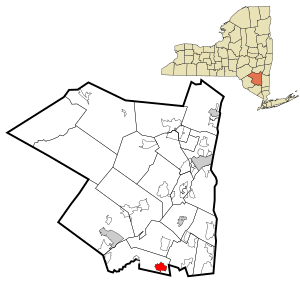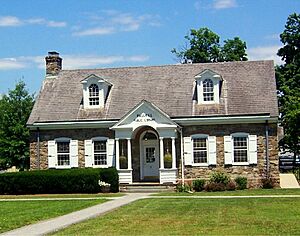Wallkill, Ulster County, New York facts for kids
Quick facts for kids
Wallkill
|
|
|---|---|

Location in Ulster County and the state of New York.
|
|
| Country | United States |
| State | New York |
| County | Ulster |
| Area | |
| • Total | 3.1 sq mi (8 km2) |
| • Land | 3.1 sq mi (8 km2) |
| Population
(2020)
|
|
| • Total | 2,166 |
| • Density | 699/sq mi (270/km2) |
| Time zone | UTC-5 (Eastern (EST)) |
| • Summer (DST) | UTC-4 (EDT) |
| ZIP codes |
12589
|
| Area code(s) | 845 |
| GNIS feature ID | 968702 |
Wallkill is a small community in Ulster County, New York, in the United States. It's known as a "hamlet," which is a type of small village, and also a "census-designated place" (CDP). This means it's a specific area that the government counts for population, even though it's not officially a town or city. Wallkill is mostly in the town of Shawangunk, New York, but parts of it stretch into nearby areas of Orange County, New York.
The community is identified by its ZIP code 12589 and telephone exchange 895. Most of the Wallkill Central School District is also located here. In 2020, about 2,166 people lived in Wallkill.
Wallkill is home to the Wallkill Correctional Facility and Shawangunk Correctional Facility. Fun places to visit include the Walden–Wallkill Rail Trail, which is great for walking or biking. You can also see the original Borden Farm, which gave its name to the local middle school, John G. Borden Middle School. The Wallkill River flows nearby, and there's the Magnanini Winery. Wallkill is also close to the beautiful Shawangunk Mountains.
Contents
History of Wallkill
Early Inhabitants
Before Europeans arrived, the Wallkill area was home to the Munsee branch of the Lenape people. These Native Americans lived in the upper Delaware Valley and parts of what is now New York and New Jersey.
One specific group, the Waronawanka, also known as the Esopus Indians, lived in the Rondout-Wallkill Valleys and the Shawangunk Mountain region. They lived there until their land bordered other tribes to the south and southwest.
Conflicts and Treaties
The Esopus people had conflicts with the Dutch settlers, known as the Esopus Wars. Other Native American tribes, like the Mohicans and Mohawks, sometimes helped mediate between the Esopus and the Dutch.
In 1664, a peace treaty ended the last major conflict. Later that same year, the Dutch lost their North American lands to the English. By 1684, the Esopus tribe had sold most of their traditional lands to the colonies. However, many Native Americans continued to live on parts of the land for several more decades.
European diseases also greatly affected the Lenape population, as they had no natural protection against them. The last known land sale by an Esopus Indian in Ulster County happened in 1770.
Watchtower Farms
Wallkill is also a popular place for visitors to Watchtower Farms. Tens of thousands of people visit each year for a free guided tour of its printing facility. The Watchtower Society, which is connected to Jehovah's Witnesses, has run this facility since 1963.
Initially, it produced food for volunteers working at their offices in Brooklyn, New York. Printing of their magazines, Awake! and The Watchtower, started at Wallkill in 1973. By 2004, all their printing operations for the United States moved from Brooklyn to an expanded facility in Wallkill. The Watchtower printery is known for its advanced automated printing, binding, and packaging. It is one of the largest in-plant printing operations in the United States, besides those run for the government.
Historic Buildings
Several historic buildings in Wallkill are listed on the National Register of Historic Places. These include the Walstein Childs House, the J. B. Crowell and Son Brick Mould Mill Complex, the Andries DuBois House, and the Reformed Dutch Church of New Hurley.
Geography
Wallkill is located at 41°36′N 74°10′W / 41.600°N 74.167°W. According to the United States Census Bureau, the community covers a total area of 3.1 square miles (about 8.0 square kilometers), and all of it is land.
The Wallkill River flows north right past the hamlet, adding to its natural beauty.
Population Information
| Historical population | |||
|---|---|---|---|
| Census | Pop. | %± | |
| 1960 | 1,215 | — | |
| 1970 | 1,849 | 52.2% | |
| 1980 | 2,064 | 11.6% | |
| 1990 | 2,125 | 3.0% | |
| 2000 | 2,143 | 0.8% | |
| 2010 | 2,228 | 4.0% | |
| 2020 | 2,166 | −2.8% | |
In 2000, there were 2,143 people living in Wallkill. There were 788 households, and 556 of these were families. The population density was about 697 people per square mile.
About 39% of the households had children under 18 living with them. Most households (57.7%) were married couples. About 25.4% of all households were made up of people living alone.
The population was spread out by age:
- 28.9% were under 18 years old.
- 8.0% were between 18 and 24.
- 30.8% were between 25 and 44.
- 22.4% were between 45 and 64.
- 9.8% were 65 years or older.
The average age in Wallkill was 35 years. For every 100 females, there were about 97.5 males.
See also
 In Spanish: Wallkill (condado de Ulster) para niños
In Spanish: Wallkill (condado de Ulster) para niños


